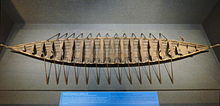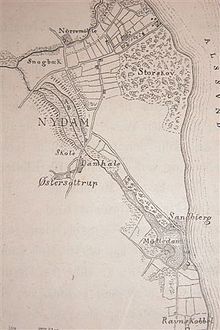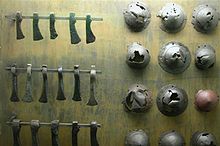Nydam boat

The Nydam boat or Nydam ship ( Danish : Nydambåden ) is a rowing boat that was sacrificed around 320 AD in the Nydam Moor ( South Jutland ) and dug up again in 1863 . It was a seaworthy war vehicle that, as a fast troop transport, could carry up to 45 men. The Nydam boat is exhibited for visitors in the Nydam Hall of the State Archaeological Museum in Gottorf Castle in Schleswig .
The ship
The Nydam Boat has a hull in clinker- m with an original length of 22.84 m and a maximum width of 3.26. The overlapping planks were connected to one another with iron rivets , which gave the hull great strength. Woven wool and a tarry mass served as a seal. It was previously assumed that the planks were in one piece and stretched the entire length of the hull. However, recent research shows that most planks are made up of two parts. These were lashed together in an overlapping step. In contrast to, for example, the Hjortspring boat , which was about 670 years older , the slim-built ocean-going vessel had a real bow that was pulled up and connected to the floor plank . As with the Hjortspring boat, the oak frames were tied to tenons that were left standing when they were hewn. These so-called cleats also served as a support for the throws (row benches).
The boat had no sails device and was alone for the drive belt set, where the rowers sat with his back facing forward. As oarlocks trimmed and the served gunwale laced forks, called Keipen which were decorated differently.
In 1997, two 1.3-meter-long wooden posts with carved heads about 40 cm high were found. These were located near the site of the stevens of the Nydam boat, so it is assumed that they were also attached there. There are also only conjectures about their function, such as the fact that the head pieces protruding over the gunwale served as cleats for mooring the ship.
The crew of the boat consisted of 45 men, 36 of them rowers at the oars.
The felling date of the timber of the Nydam boat could be dendrochronologically dated to the period between 310 and 320 AD. It is likely that the ship was sunk in the former sacrificial lake between 340 and 350. The origin of the wood indicates that it was built in Denmark , Schleswig-Holstein or Skåne .
The Halsnøy boat was found on the island of Halsnøya in Fylke Vestland in Norway in 1896 . It dates from the same period and is built similarly.
The discovery
In the period from 1859 to 1863, the Danish archaeologist Conrad Engelhardt undertook extensive excavations in Nydam Moor , about 8 km from the town of Sønderborg . Shortly before the outbreak of the German-Danish War , Engelhard managed to find the Nydam ship, which he reconstructed in the same year and exhibited in the so-called Flensburg Collection ( Flensborgsamlingen ).
History of the Nydam boat
What makes the Nydam boat appear particularly interesting in relation to other finds is, among other things, the important role it played in the national disputes between Prussia and Denmark such as the German-Danish War and the First and Second World Wars . After the German-Danish War, the boat passed into Prussian ownership in 1864, along with other finds from the Nydam Moor from Engelhard's Flensburg collection. In 1877 the Nydam ship was transferred to the Museum of Patriotic Antiquities in Kiel as part of the Flensburg collection at the time , and exhibited there in the building's attic. After the referendum on the reorganization of the German-Danish border in 1920 , the location belonged to Denmark, but the boat and other finds were in Germany.
During the Second World War, the Nydam boat was removed from Kiel and stored in a barge in Möllner See , where it survived the war undamaged. In 1946 it was brought over the Kiel Canal, the Baltic Sea and the Schlei to the Archaeological State Museum Schleswig-Holstein at Gottorf Castle, where it has since been exhibited in the specially set up Nydam Hall despite Danish demands for return after both World Wars . In May 2003 the Nydam boat was loaned to the Danish National Museum in Copenhagen until March 2004, where it was exhibited in a specially built, elaborate hall. During this time, a reconstruction of the Hjortspringboot was exhibited in the hall.
panorama
literature
- Güde Bemmann, Jan Bemmann: The sacrificial place of Nydam. The finds from the older excavations, Nydam-I and Nydam-II . Ed .: Archaeological State Museum Schleswig. Wachholtz, Neumünster 1998, ISBN 3-529-01827-9 .
- Michael Fee, Mechtild Freudenberg: Nydam and Thorsberg. Iron Age sacrificial sites. Booklet accompanying the exhibition . Ed .: Archaeological State Museum Schleswig. 2000.
- Herbert Jankuhn: Nydam and Thorsberg. Iron Age bog finds. Guide through the collection . Ed .: Schleswig-Holstein State Museum for Pre- and Early History. tape 3 . Wachholtz, Neumünster 1983, ISBN 3-529-01603-9 .
- E. Jørgensen, P. Vang Petersen: Nydam mose - nye fund og iagttagelser . In: Sejrens triumf. North i skyggen af det romerske imperium. Udstilling catalog. National Museum 2003.
Individual evidence
- ↑ Gottorf Castle celebrates the discovery. Retrieved January 5, 2013 .
- ↑ Nydam Mose ( memento of January 24, 2014 in the Internet Archive ) accessed on January 24, 2014.
- ↑ The Nydam Ships (English) accessed on January 24, 2014.
- ↑ Karsten Kjer Michaelsen: Politics bog om Danmarks oldtid . Copenhagen / København 2002, ISBN 87-567-6458-8 , p. 138 .
- ↑ Nydambåden - Et krigsskib fra jernalderen ( Memento from January 8, 2010 in the Internet Archive )
Web links
- State Museum Schloß Gottorf. Retrieved November 27, 2011 .
- Homepage of the Nydam Society. Retrieved November 27, 2011 .
- Flickr Set-Nydam Mose. Retrieved November 27, 2011 .
Coordinates: 54 ° 57 ′ 10 " N , 9 ° 43 ′ 23" E









